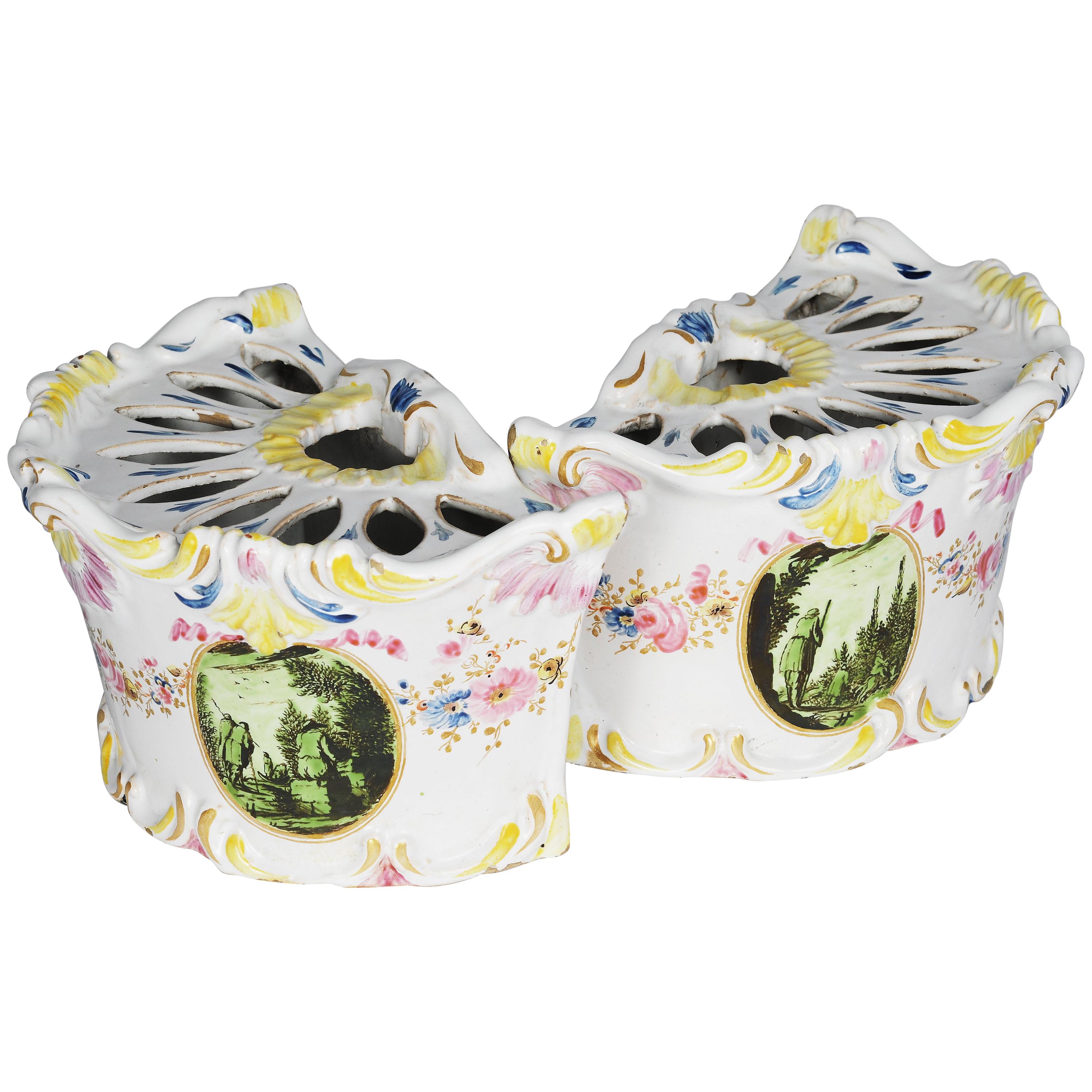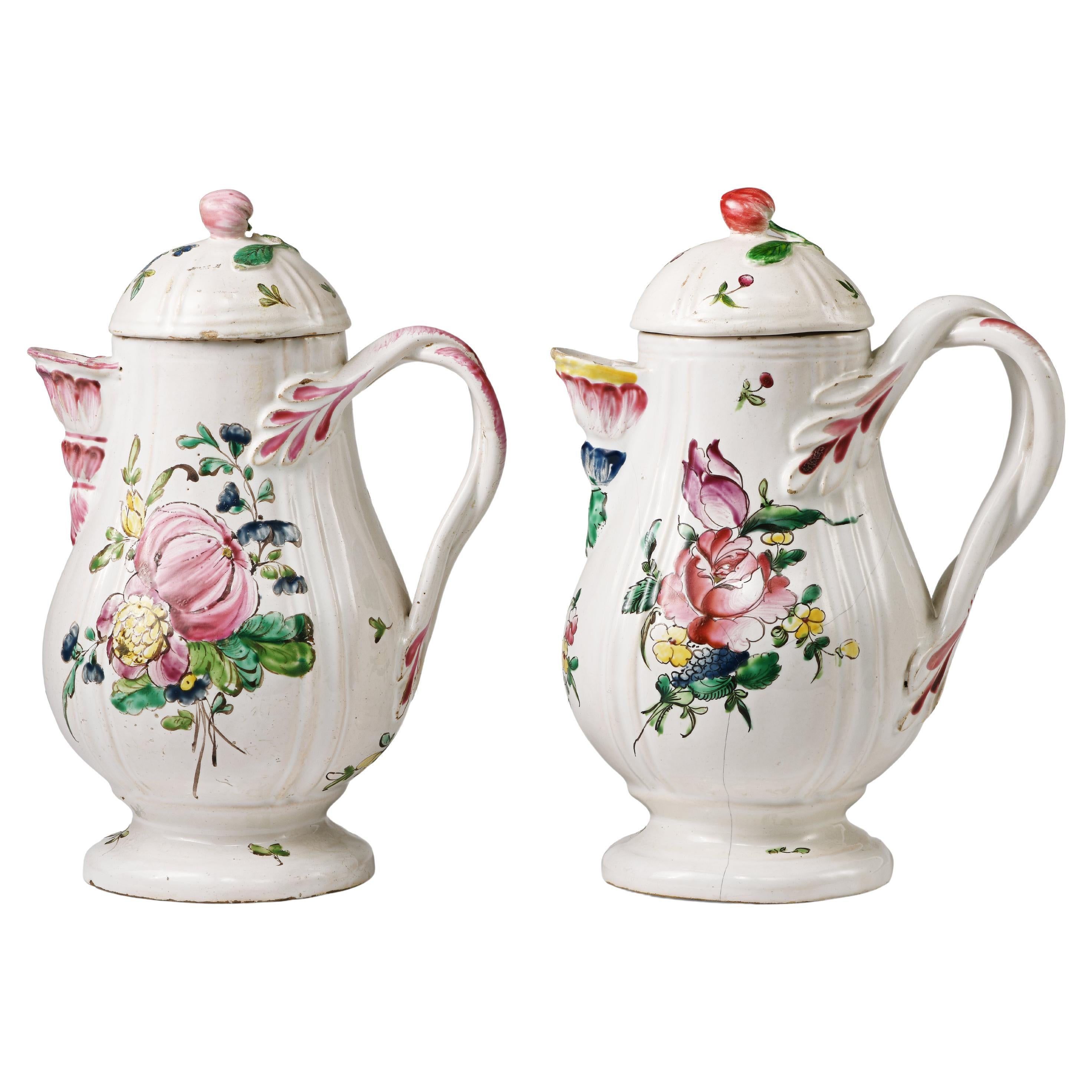Items Similar to Ancient Maiolica Cup, Rubati Manufacture, Milan, Circa 1770 - 1780
Video Loading
Want more images or videos?
Request additional images or videos from the seller
1 of 15
Ancient Maiolica Cup, Rubati Manufacture, Milan, Circa 1770 - 1780
About the Item
Sick cup
Pasquale Rubati Manufacture
Milan, Circa 1770 - 1780
Maiolica decorated in polychrome “a piccolo fuoco” (third fire)
It measures: h 2.36 x 7.4 x 7.87 (h 6 x 19 x 20 cm)
It weighs: 6.17 lb (28 g)
State of conservation: the cup is intact except for a few very thin cracks due to heat on the basin.
Maiolica and porcelain production in the eighteenth century belonged mainly to the great royal families or in any case to the noble families who made the manufacture of ceramic works a source of prestige. In Milan, under Maria Teresa of Austria, the time period witnessed a real opening to new industrialists who, by virtue of the privatizations granted by the government, assumed a real business risk, giving life, albeit not without conflict, to flourishing factories and to production which was among the most elegant and most requested at the moment and which still today remains object of collection.
In Milan in the 18th century, two majolica factories were active. The first was that of Felice Clerici, from 1745, and the second was opened by Pasquale Rubati in 1756, in competition with Felice, for whom he had been a worker. Upon Rubati's death, in 1796, the enterprise was continued for a few years under his son Carlo.
This hemispherical cup, with slight pods and a wavy edge, rests on a low and flat foot. On the sides, just below the mixtilinear edge, there are two horizontal handles which are decorated in relief. On the front, half of the cup is partially closed and, in the lower part of the cup, there is a long spout which curves upwards. This is the typical shape of sick cups: it facilitated the intake of liquids for those who were confined to bed and prevented the contents spilling.
There are polychrome flowers arranged along the body and the decoration of the cover depicts a flower bouquet with a tulip in the center, accompanied by small four petal blue and yellow florets and a sprig of yellow and blue. Some semis of flowers, with two-tone blue and purple petals, scatter leaves on the remaining surface to complete the decoration. The motif, expertly traced within thin manganese outlines, differs from that more commonly known as "alla rosa contornata"( “to the contoured rose”) or "alla vecchia Lodi" (“in old Lodi style”), precisely by virtue of the presence of small multicolored florets. It constitutes one of the most elegant ornamental styles offered by the Milanese Pasquale Rubati manufacture during the 18th century.
In 1760 the innovative “a piccolo fuoco” (third fire) technique expanded the ornamental repertoire with Saxon-inspired floral themes and produced works which could commercially compete with the German porcelains whose most renowned offerings included the naturalistic Deutsche Blumen.
This choice of decoration, which had represented a strong point of the Lodi Ferretti factory, is here elaborated by Pasquale Rubati with results very similar to those obtained by painting on porcelain.
Pasquale Rubati was originally from Lodi, where he had worked at the Rossetti factory. Later he moved, first to Turin and then to Milan, where he is reported among the painters of the Clerici manufacture. Subsequently, he left this factory to open his own. Despite having been accused by Clerici of taking away from his manufacture "the secrets of the colors", that is to say the recipes of the “a piccolo fuoco” (third fire) colors, Pasquale Rubati distinguished himself through his extraordinary talent as a painter and the quality of his works. Indeed, the refinement of the decorations often successfully competed with porcelain.
The cup was published in the 1960's as a work of Lodi production and has only recently been ascribed to be a work similar to others of Rubati manufacture (S. Levy, Maioliche settecentesche lombarde e venete, Milano 1962, tav. 204, e A. Novasconi, S. Ferrari, S. Corvi, La ceramica lodigiana, Lodi 1964, p. 230-231).
Bibliography
S. Levy, Maioliche settecentesche lombarde e venete, Milano 1962, tav 204;
Gregorietti, Maioliche di Lodi, Milano e Pavia (catal.), Milano 1964, p. 17;
A. Novasconi, S. Ferrari, S. Corvi, La ceramica lodigiana, Lodi 1964, p. 230-231O. Ferrari - G. Scavizzi, Maioliche italiane del Seicento e del Settecento, Milano 1965;
M. A. Zilocchi, in Settecento lombardo, Milano 1991;
R. Ausenda (a cura di), Musei e Gallerie di Milano. Museo d’Arti Applicate. Le ceramiche. Tomo secondo, Milano 2000.
- Creator:Pasquale Rubati (Manufacturer)
- Dimensions:Height: 2.37 in (6 cm)Width: 7.49 in (19 cm)Depth: 7.88 in (20 cm)
- Style:Rococo (Of the Period)
- Materials and Techniques:Maiolica,Glazed
- Place of Origin:
- Period:1770-1779
- Date of Manufacture:circa 1770-1780
- Condition:The cup is intact except for a few very thin cracks due to heat on the basin.
- Seller Location:Milano, IT
- Reference Number:1stDibs: LU4352227500962
About the Seller
4.3
Vetted Seller
These experienced sellers undergo a comprehensive evaluation by our team of in-house experts.
Established in 1860
1stDibs seller since 2018
19 sales on 1stDibs
Typical response time: 4 hours
Associations
International Confederation of Art and Antique Dealers' Associations
- ShippingRetrieving quote...Ships From: Milano, Italy
- Return PolicyA return for this item may be initiated within 14 days of delivery.
More From This SellerView All
- Ancient Italian Maiolica Tureen, Rubati Manufacture, Milan, circa 1770-1780By Pasquale RubatiLocated in Milano, ITMaiolica tureen Pasquale Rubati Manufacture Milan, circa 1770 - 1780 Maiolica polychrome decorated “a piccolo fuoco” (third fire). It measures 6.69 in x 11,02 x 8.26 (17 x 28 x ...Category
Antique 1770s Italian Rococo Ceramics
MaterialsMaiolica
- Ancient Maiolica Plates Pasquale Rubati, Milan Circa 1770-1780By Pasquale RubatiLocated in Milano, ITFive oval maiolica dishes with pierced edge Manufacture of Pasquale Rubati Milan, 1770-1780 Three small oval dishes 10.23 in x 7.67 in (26 cm x 19.5 cm) Two large oval dishes 10.82 in x 8.85 in (27.5 x 22.5 cm) lb 3.5 (kg 1.8) State of conservation: intact The five dishes of different sizes have an oval shape, a mixtilinear edge and a molded polylobed shape with a surface enriched with a relief weave motif extending to the brim and forming a perforated basket...Category
Antique 1770s Italian Rococo Ceramics
MaterialsMaiolica
- Antique Italian Maiolica Coolers Pasquale Rubati Manufacture Milan, 1770 CircaBy Pasquale RubatiLocated in Milano, ITAssortment of bottle and glass coolers in Maiolica. Pasquale Rubati manufacture Milan, circa 1770 Maiolica polychrome decorated “a piccolo fuoco” (third fire) a - Bottle cooler 5.91 in x 5.91 in diameter (15 x 15 cm ) Weight: 1.86 lb (845 g) b - Bottle cooler 6.89 x 7.87 in diameter (17,5 x 20 cm) Weight: 2.09 lb (948 g) c - Pair of glass-cooler vases 3.94 x 3.94 in diameter (10 x 10 cm) Weight: 1.43 lb (650 g) Good state of conservation: a - some chipping from use on the edge; a - two fêlures covered on the edge; c - one has deep chippings on the edge and the other a subtle fêlure. Two Majolica factories were active in Milan in the 18th century. The first, starting from 1745, was owned by Felice Clerici; the other one by Pasquale Rubati from 1756. Rubati was in competition with Felice, whose worker he had been prior to opening his own workshop. On his death in 1796, the business was continued for a few more years by his son Carlo. Recent studies have recognized Pasquale Rubati's contribution as the creator of "Strasbourg-style" decorations with their particularly joyful depictions. This style had previously been attributed to the Lodi manufacturers. These works here, however, are a clear example of this production. The Majolica containers have different sizes, a cylindrical shape and rest on a low foot ring. The two largest are completed by handles in the shape of a zoomorphic mask with wide open jaws, while the smaller ones have handles applied with an anthropomorphic mask. All the works are characterized by elegant floral decoration. The two twin glass coolers show bunches of flowers centered around a main corolla, a rose or a peony paired...Category
Antique 1770s Italian Rococo Ceramics
MaterialsMaiolica
- Ancient Maiolica Flower Pot Pasquale Rubati Factory, Milan Circa 1770By Pasquale RubatiLocated in Milano, ITMaiolica flower pot “a mezzaluna” decorated with tulip Pasquale Rubati Factory Milan, circa 1770. Measures: 4.7 in x 4.7 in x 8.6 in 12 cm x 12...Category
Antique 1770s Italian Rococo Ceramics
MaterialsMaiolica
- Pair of Ancient Italian Maiolica Flower Pots Milan, Rubati Factory, 1770 circaBy Pasquale RubatiLocated in Milano, ITMaiolica flower pot “a mezzaluna” decorated with trompe l’oeil Pasquale Rubati Factory Milan, circa 1770 Measures: each 4.7 in (cm 12) x 5 in (c...Category
Antique 1770s Italian Rococo Ceramics
MaterialsMaiolica
- Ancient Pair Coffee Pots, Pasquale Rubati Manufacture Milan, 1770 circaBy Pasquale RubatiLocated in Milano, ITPair of small coffee pots. Manufacture of Pasquale Rubati Milan, 1770 Circa Maiolica polychrome decorated “a piccolo fuoco” (third fire). a) height 7.87 x 5.51 x 3.93 in (20 x 14 x ...Category
Antique 1760s Italian Neoclassical Ceramics
MaterialsMaiolica
You May Also Like
- First Period Worcester Coffee Cup Porcelain Finely Hand Painted, circa 1770By 1st Period Worcester Dr. WallLocated in Lincoln, LincolnshireThis is a rare first period (or Dr. Wall) Worcester Coffee Cup, with a distinctive hand painted pattern, made of porcelain and dating to the 18th century, circa 1770. The cup is well potted with a grooved loop handle This delightful early Worcester Cup...Category
Antique 18th Century English George III Ceramics
MaterialsPorcelain
- Circa 1770 Delft Blue & White PlateLocated in Chapel Hill, NCCirca 1770 Delft blue & white plate. Central handled & footed basket vase overflowing with flowers, surrounded by alternating repetive floral vases & naturalistic motifs. Frits comme...Category
Antique 1770s Dutch Ceramics
MaterialsCeramic
- Late 18th Century Blue And White Glazed Faience Charger, circa 1770, DenmarkLocated in Haddonfield, NJA large Danish (or Northern German) faience charger from circa 1780 in blue and white flower decor. The decoration is inspired by, or actually exact copies of the contemporary Chine...Category
Antique Late 18th Century Danish Rococo Ceramics
MaterialsFaience
- Antique English Creamware 18th Century Sweetmeat Platt Menage circa 1780-1790By Leeds PotteryLocated in Katonah, NYWe are thrilled to offer this fabulous large three-tiered 18th-century creamware platt menage, made circa 1780-90 in Staffordshire or Yorkshire, England. It is a rare and elegant ex...Category
Antique Late 18th Century English Rococo Centerpieces
MaterialsCreamware
- Turquoise Maiolica Italian Albarello Late, 1800sLocated in Roma, ITThis beautiful turquoise maiolica patterned Italian albarello (late 1800s early 1900s) was found in Palazzo Torlogna in Rome. Albarelli were ancient storag...Category
Antique Early 19th Century Italian Greco Roman Ceramics
MaterialsMaiolica, Ceramic
- Rare Meissen Marcolini Tulip in a Tub circa 1780 PorcelainBy Meissen PorcelainLocated in London, GBA Superb Meissen Marcolini tulip in a tub, Circa 1780. Fine quality Meissen porcelain model of a flowerpot, modelled as cylindrical tub enhanced in gilt with 2 mythological masks on...Category
Antique 1780s German Ceramics
MaterialsPorcelain





